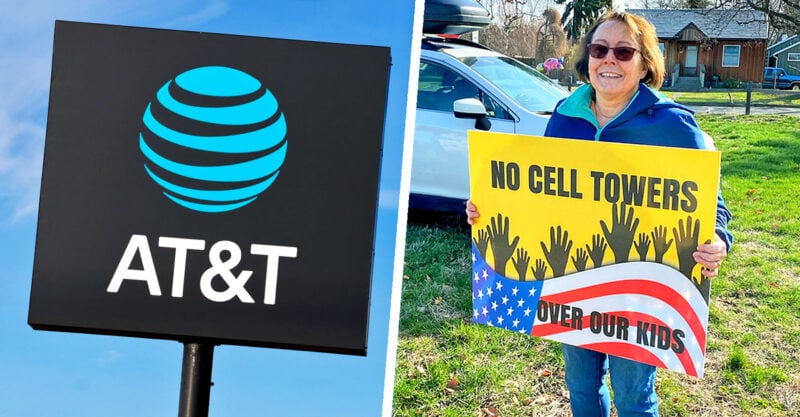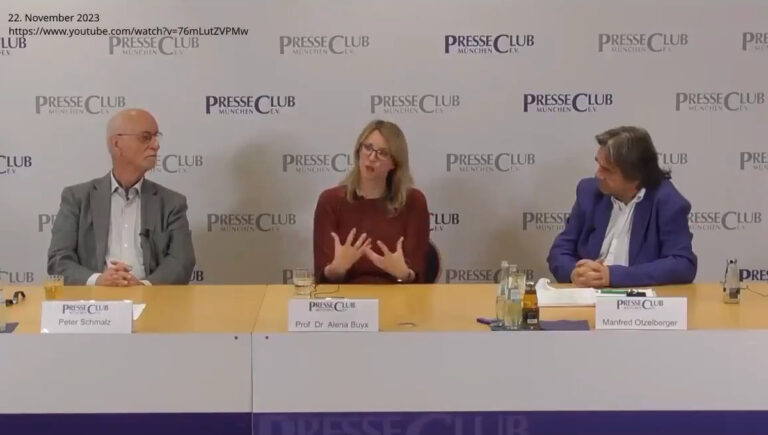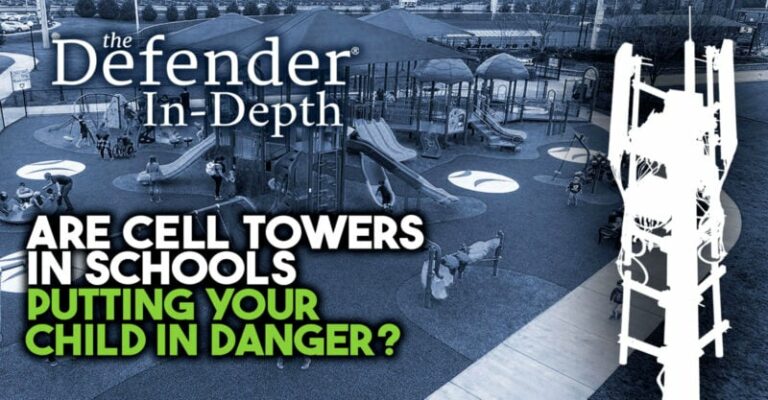Couple Who Fears Cell Tower Could Disrupt Pacemaker Wins Right to Intervene in AT&T Lawsuit
Barbara and Everett Knudson won the right to intervene in a federal lawsuit AT&T brought against the City of Walla Walla, Washington, after city officials denied the telecom giant’s application to build a 65-foot cell tower behind a church.
Two residents of the City of Walla Walla, Washington, won the right to intervene in a lawsuit AT&T brought against Walla Walla in federal court after city officials denied the telecom giant’s application to build a 65-foot cell tower behind a church.
Walla Walla city officials said AT&T’s application did not meet the requirements set out in the city’s code. They also said they’ve been hearing from their constituents that the cell tower poses a fire risk and doesn’t belong in a residential neighborhood.
Barbara Knudson, a retired building contractor, and her husband, Everett, a retired CEO and owner of an electrical company, own property next to Blue Mountain Community Church where AT&T wants to erect the tower.
The Knudsons said if AT&T builds the tower they’ll be forced to leave their home of 38 years because the radiofrequency (RF) radiation emitted by the tower would jeopardize their health, especially Everett’s.
Everett, age 78, had a heart attack and stroke 10 years ago that left him with severe heart failure and arrhythmias that put him at risk for another stroke.
He’s now 100% reliant on a pacemaker. He limits his exposure to RF radiation because it can interfere with his pacemaker, Barbara told The Defender.
“My husband was an electrical contractor and understands these structures and what they emit,” she said, “If his pacemaker falters for any reason he will have no heartbeat and will die within minutes.”
Everett’s situation is potentially life-threatening. But under federal law — including the Telecommunications Act of 1996 — local governments are prohibited from considering the environmental effects of RF radiation, including health effects, of a proposed wireless project as long as the project complies with the Federal Communication Commission’s rules on RF emissions.
In other words, the Knudsons can’t base a lawsuit against AT&T on the argument that the tower would put Everett’s health at risk or harm the environment. So they are using other legal arguments — including how the proposed cell tower poses a fire risk — in an attempt to prevent AT&T from building the tower.
Timothy Donaldson, the attorney representing Walla Walla in the lawsuit, submitted an affidavit to U.S. District Judge Stanley A. Bastian supporting the Knudsons’ motion to intervene in the case. Judge Bastian earlier this month granted the motion, despite AT&T’s motion urging the court to keep the Knudsons out of the suit.
The case goes to trial on Nov. 12.
AT&T asked the court for declaratory and injunctive relief — meaning the telecom giant wants the judge to tell the city it can’t stand in AT&T’s way of its plans to build the tower.
AT&T claims the Telecommunications Act of 1996 doesn’t allow local governments to block such wireless projects because of “nationwide goals of promoting widespread availability of advanced, reliable wireless services.”
The city maintains that the wireless company’s application for the tower did not meet the city’s code.
In a letter to Blue Mountain Community Church, the Knudsons explained their concerns about being bombarded 24/7 with RF radiation from the tower that may be built on its rear lawn.
The church said it only leases the property and has no liability for what is placed on it, Barbara said.
It is not publicly known how much money AT&T is offering the church for the use of its lawn, she added.
Cell tower would impact inn guests, daycare children
It’s not just Everett’s health the Knudsons fear will be harmed by the cell tower. The church runs a daycare that serves roughly 100 children. Its playground would be about 200 feet from the tower.
“Many of these children get state coupons and very few daycares accept them, so these moms are forced to continue to send their children there even if they have concerns” about how the RF radiation exposure might impact their kids’ development and health.
Barbara and Everett also run a vintage farmhouse bed and breakfast, Inn at Blackberry Creek, less than 500 feet from the proposed tower site.
If AT&T gets its way, the Inn at Blackberry Creek will close, Barbara said, noting that many of the inn guests are battling cancer and heart issues.
“Our inn is like being in the country in the middle of town, so it might be the relaxed atmosphere and gardens that attract them,” Barbara said. “We cannot in good faith choose to house people who are trusting a safe environment and not getting one.”
The inn’s environment — which includes a pasture with creeks, stands of blackberries and a host of wildlife such as deer, wild turkey, blue heron, hawks and many songbirds — would be forever changed if a huge cell tower goes up next to it.
The inn survived the economic turmoil after Sept. 11, the market downturn of 2008 and COVID-19. “Now the cell tower looms over us,” she said. “We will fight it, but this is truly a battle fighting a multibillion-dollar corporation. But if we don’t fight them, the cell tower will happen for sure.”
‘Like a giant green toilet bowl brush’
The Knudsons’ intervention in the lawsuit is the latest twist in a legal battle between AT&T and Walla Walla over the telecom giant’s conditional-use permit application — filed Nov. 7, 2022 — for building the tower on Blue Mountain Community Church’s land.
Upon first hearing of AT&T’s plans, Walla Walla residents quickly mobilized to educate themselves and others on the tower’s possible impacts on the environment, their health and their property values.
“We spent a year going to city council meetings twice a month and speaking on this,” Barbara said. “We were quickly told that health and safety would not be considered in the siting of the tower.”
More than a dozen residents spoke against the tower during a public hearing on Sept. 21, 2023, saying the cell tower would be an unwelcome landmark over their naturally forested neighborhood, reported the Walla Walla Union-Bulletin.
In November 2023, the city’s hearing examiner — a professional hired for deciding land use permit applications in Washington state — denied AT&T’s application, noting that the company hadn’t adequately looked for other possible locations for its tower.
The hearing examiner also objected to AT&T’s proposed “stealth” design intended to disguise the tower as a pine tree. “It certainly does not look like a natural tree that blends in with the surrounding environment,” he wrote.
Barbara agreed. “It will tower over our tree line like a giant green toilet bowl brush 35 feet over the existing tree line,” she said, “and it can grow another 20 feet out and up within a year per federal laws.”
Blue Mountain Community Church sold another portion of its land to a developer who designed a housing development adjacent to the proposed tower. The church did not tell the developer it had leased another part of its property to AT&T for the proposed tower.
Having a cell tower looming over the homes at the end of a cul-de-sac may make some — if not all — of the lots unsellable, Barbara said. “There is a current lawsuit awaiting the outcome of this lawsuit for fraudulent concealment of a material fact in a real estate transaction.”
Tower poses fire risk
According to Barbara, AT&T’s proposed cell tower would create a big fire risk.
“We have already had a fire in this area 15 years ago that burned a portion of the tree line and snapped the main power line that runs beside and behind where this tower will be.”
The power line that snapped caught trees on fire over 300 feet away, she said.
The tower’s proposed site is surrounded on four sides by the church and daycare, existing homes and a proposed housing development. “It takes a fair amount of time to cut the power and the closest fireplug is over 800 feet away,” Barbara said.
For over a year, concerned residents have picketed in front of the church every Sunday bearing signs with phrases such as “No cell towers over our kids.” They plan to keep it up until the Nov. 12 trial, Barbara said.
What about health and the environment?
Barbara found it disturbing that wireless providers like AT&T deny any responsibility for how their actions may impact people’s health and the environment.
“The big red flag in all of this,” she said, “is the statement in AT&T’s application that quotes federal law stating that health and the environment cannot be considered in this application.”
In other words, cities can’t legally use the argument that “this cell tower will harm people’s health and the environment” to deny a wireless application.
In Barbara’s view, that law needs to change.
Health and the environment are the “foundations” of a good building project. “To exclude them and to shelter cell companies from liability has allowed these companies to run amuck and show no empathy or concern for those near these towers,” she said.
This is far from a solid business plan for any company and it “certainly is not good building practice to allow harm to others with no concern,” she said.
AT&T lawyers in the suit did not respond to The Defender’s request for comment.
Donaldson, city attorney for Walla Walla, also did not respond to The Defender’s request for comment.
Suggest a correction







